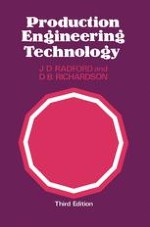1980 | Buch | 3. Auflage
Production Engineering Technology
verfasst von: J. D. Radford, B.SC. (ENG.), M.I.MECH.E., F.I.PROD.E., D. B. Richardson, M.PHIL., D.I.C., F.I.MECH.E., F.I.PROD.E., A.M.B.I.M.
Verlag: Macmillan Education UK
Enthalten in: Professional Book Archive
